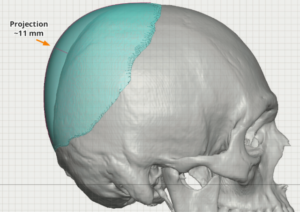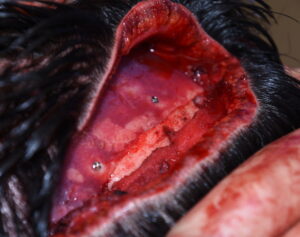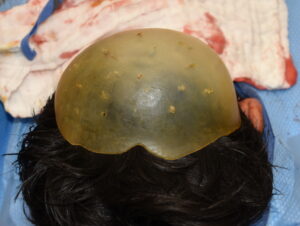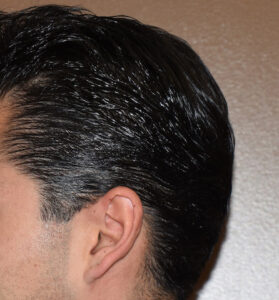Background: Aesthetic skull reshaping surgery consists of a wide variety of reductive and augmentative procedure for head shape concerns. One of the most common augmentative procedures is for the back of the head using a custom designed skull implant. This is done for concerns of asymmetry, lack of adequate projection or a combination of both.
Not surprisingly the majority of such skull augmentations are done in men for the obvious reason of greater head shape exposure. While the lack of hair, or they desire to shave their heads, is why many men seek the procedure this is not exclusively so. A surprising number of men with more ‘hidden’ head shape are bothered by them nonetheless. This may be as much of a tactile issue as it is a visual one.
In correcting back of the head shapes it is often called occipital augmentation or occipital bone reshaping. This is because most think of the back of head as being the entire occipital bone…which it is not. Anatomically the occipital bone actually only makes up the lower half of the back of the head. The upper half, which lies north of the lambdoidal sutures is the paired parietal bones. This not only makes up the upper half of the back of the head but also includes a portion of the crown which involves the back end of the sagittal suture. These bony anatomic areas must be considered in any custom skull implant design for the back of the head.




Asymmetry of the back of the head, in theory, is the most straightforward skull implant to design. This is true IF it is only the asymmetry that is desired to be corrected. But adding an increased overall projection and the need to take into consideration how much implant volume it creates overall adds to the complexity of the design. It is a good guideline for most patients to not design skull implants that have volumes that stay within the 150cc range. Skull implants are unique in that their surface area coverage and thickness create a volumetric effect that requires the tight scalp over it to stretch to accommodate it.
Case Highlights:
1) Back of head augmentations for asymmetry and an overall volume increase are the most common custom skull implants in men.
2) Where on the back of the head the maximum projection should be will vary for each patient.
3) The maximum volume for most skull implants based on scalp stretch is in the range of 150ccs.
Dr. Barry Eppley
Indianapolis, Indiana









